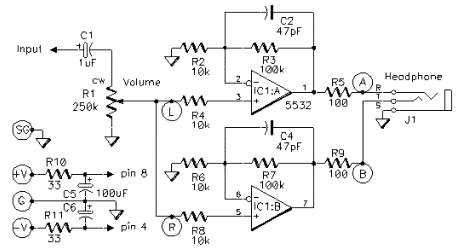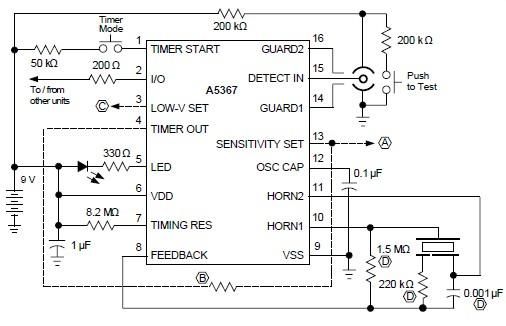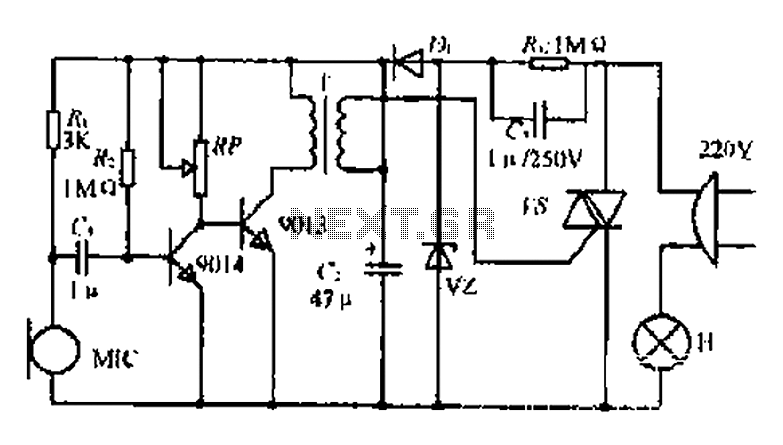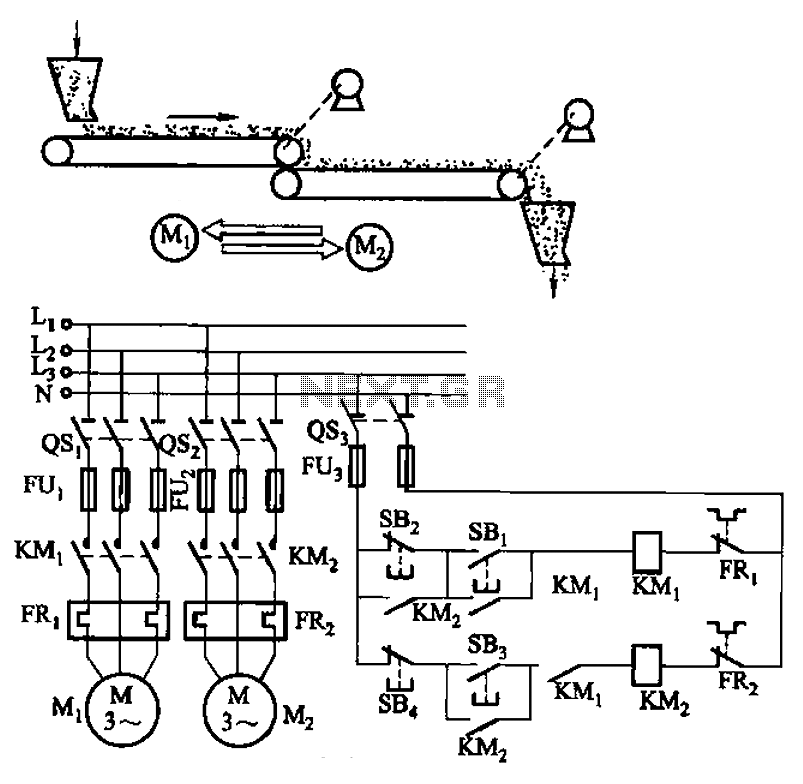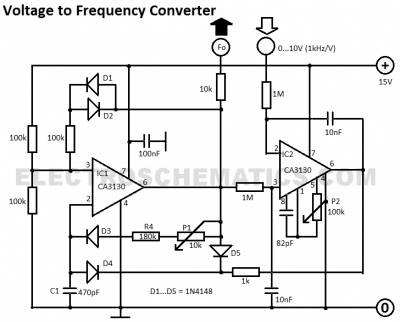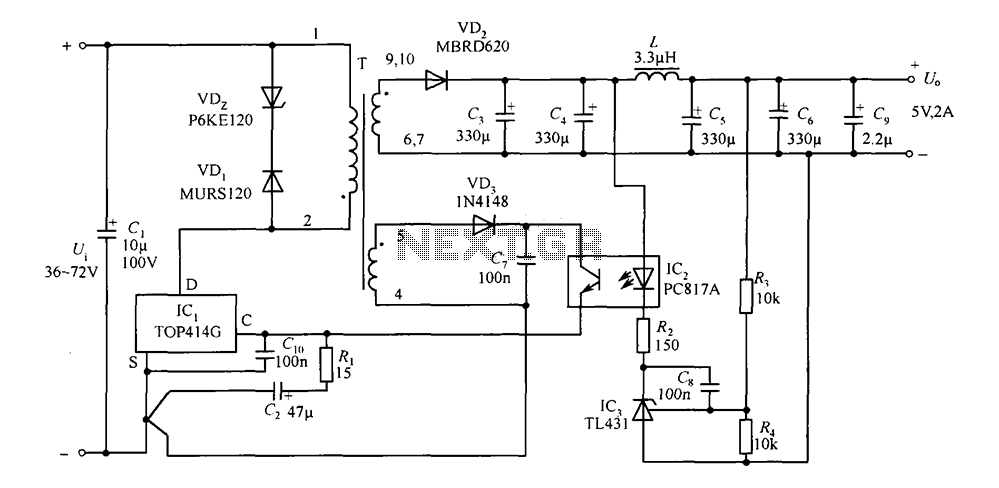
expand from one 15 pin d-sub VGA output to multiple others circuit

The circuit expands a single 15-pin D-sub VGA output to multiple outputs, allowing for the connection of up to six monitors simultaneously. The input VGA connector is positioned on the left side, while the six output VGA connectors are located on the right side. The circuit design is straightforward but involves numerous connections. Each output connector utilizes five transistors, with quad ECG2322 transistors used in the design, requiring a total of eight to support six monitors. The circuit's unique feature is its scalability, permitting the connection of additional monitors beyond six, although this implementation is limited to six. This scalability is possible because the circuit draws minimal current from the input source, as the input connects to the base of the transistors. The nearly zero base current prevents significant current flow into the right half of the circuit, which is powered by a 5-volt source sourced from the PC power supply. For a more detailed explanation, refer to the original webpage. The schematic was generated using Orcad Capture 9.2.
The circuit operates by utilizing a primary VGA input signal that is split into multiple output signals for the monitors. The VGA input is connected to the bases of the transistors, which act as switches for the output connections. When a signal is present at the VGA input, it activates the corresponding transistors, allowing the video signal to pass through to the output connectors. Each output connector is connected to a separate transistor configuration, ensuring that the signal integrity is maintained across all connected monitors.
The choice of using quad ECG2322 transistors is significant due to their ability to handle the required switching without introducing excessive noise or distortion to the signal. The transistors are configured in a manner that allows for efficient signal amplification and distribution. The circuit's design minimizes the load on the VGA source, which is crucial for maintaining the performance of the primary video output.
Powering the circuit from the PC power supply ensures that there is a stable 5-volt source available for the transistors to operate effectively. This design choice also contributes to the low power consumption of the circuit, making it suitable for applications where multiple displays are needed without overloading the graphics card or the power supply.
In summary, this VGA output expansion circuit is a practical solution for users requiring multiple monitor setups, providing flexibility and ease of use while ensuring efficient power management and signal integrity. The use of Orcad Capture 9.2 for schematic generation aids in visualizing and implementing the circuit design effectively.The circuit that allows you to expand from one 15 pin d-sub VGA output to multiple others. I built upon the schematic found online here and expanded it to allow up to 6 monitors connected at once! The input VGA connector is on the left while the 6 output VGA connectors are on the right side. The circuit is very simple though th ere are a ton of wires. It basically uses 5 transistors per output connector. The boxes in the middle are quad ECG2322 transistors so I needed a total of 8 to get the 6 monitors. The amazing thing about this circuit is that I could have kept going. You can hook up as many monitors as you want, I just limited myself to 6. The reason we can keep connecting is that the circuit draws very very little current (nearly zero) from the input source due to the input connecting to the base of the transistor. The base current near zero does not let current enter the right half of the circuit. Thus, the right half is powered by a 5 volt source which I stole from the PC power supply. Check out the original webpage for a more detailed explanation. I used Orcad Capture 9. 2 to generate the schematic. 🔗 External reference
The circuit operates by utilizing a primary VGA input signal that is split into multiple output signals for the monitors. The VGA input is connected to the bases of the transistors, which act as switches for the output connections. When a signal is present at the VGA input, it activates the corresponding transistors, allowing the video signal to pass through to the output connectors. Each output connector is connected to a separate transistor configuration, ensuring that the signal integrity is maintained across all connected monitors.
The choice of using quad ECG2322 transistors is significant due to their ability to handle the required switching without introducing excessive noise or distortion to the signal. The transistors are configured in a manner that allows for efficient signal amplification and distribution. The circuit's design minimizes the load on the VGA source, which is crucial for maintaining the performance of the primary video output.
Powering the circuit from the PC power supply ensures that there is a stable 5-volt source available for the transistors to operate effectively. This design choice also contributes to the low power consumption of the circuit, making it suitable for applications where multiple displays are needed without overloading the graphics card or the power supply.
In summary, this VGA output expansion circuit is a practical solution for users requiring multiple monitor setups, providing flexibility and ease of use while ensuring efficient power management and signal integrity. The use of Orcad Capture 9.2 for schematic generation aids in visualizing and implementing the circuit design effectively.The circuit that allows you to expand from one 15 pin d-sub VGA output to multiple others. I built upon the schematic found online here and expanded it to allow up to 6 monitors connected at once! The input VGA connector is on the left while the 6 output VGA connectors are on the right side. The circuit is very simple though th ere are a ton of wires. It basically uses 5 transistors per output connector. The boxes in the middle are quad ECG2322 transistors so I needed a total of 8 to get the 6 monitors. The amazing thing about this circuit is that I could have kept going. You can hook up as many monitors as you want, I just limited myself to 6. The reason we can keep connecting is that the circuit draws very very little current (nearly zero) from the input source due to the input connecting to the base of the transistor. The base current near zero does not let current enter the right half of the circuit. Thus, the right half is powered by a 5 volt source which I stole from the PC power supply. Check out the original webpage for a more detailed explanation. I used Orcad Capture 9. 2 to generate the schematic. 🔗 External reference
